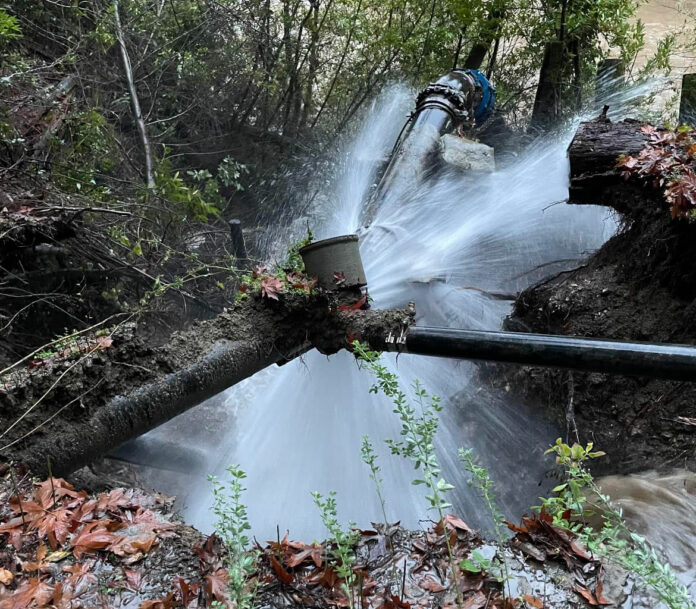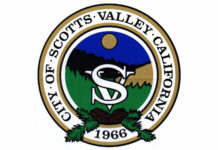Now that January’s series of atmospheric rivers has finally let up, the San Lorenzo Valley Water District has come up with a calculation of just how big of a hit it took to its infrastructure.
Earlier this week the District figured the cost to repair water mains and damage to pumps caused by PG&E outages, among other issues, could be somewhere in the neighborhood of $2.8 million.
By Wednesday, District Manager Rick Rogers had upped the figure to the $4 million range.
“Quite a few trees have fallen on pipes,” he said, running down a list of the impacts. “It was several main breaks due to ground movement, due to trees uprooting and damaging pipe, due to erosion, main breaks caused by landslides.”
SLVWD was started in 1941 and now boasts more than 7,500 metered connections in locations like Zayante, Quail Hollow, Scotts Valley, Whispering Pines, Manana Woods and Felton.
The disaster hit as the District has made slow progress on fixing infrastructure taken out by the 2020 CZU Lightning Complex Fire.
“Unfortunately, we are not as far along with the CZU fire upgrades and damage repairs as we would like to be,” Rogers said. “We have gone out to bid and tried to move ahead on construction projects, but we’ve run into supply chain delays of up to a year on pipe.”
Since the fire, the District’s replaced some small tanks, but hasn’t been able to upgrade the temporary piping in fire-damaged areas. Work is finally set to begin on the main that runs along Alta Via Road, parallel to Highway 9, next month.
Of over 100 customers forced out of service by the fire, approximately 20 have requested their service be turned back on.
“We have relied on the aquifers more since the CZU fire,” Rogers said, adding they were able to get the surface water intake at Foreman Creek up-and-running. “It’s a much shorter line and a much easier construction.”
However, when the rains arrived, SLVWD had to stop taking water from above-ground sources.
“Our treatment plants would not treat that type of water with all the leaves, limbs,” Rogers said, noting employees weren’t even able to go to the intake points because of the dangerous rushing water. “We were just able to get into Fall Creek Intake last week, due to the high flows. It was unsafe.”
When crews did arrive, they had a lot of work on their hands.
“You’ve gotta check for damage on the intake screens,” he said. “They were impacted with gravel and sand. And sometimes there’s a lot of woody debris.”
The District lost communications during the storm and employees had to physically check each pump’s status. They found a lot of problems caused by electricity.
“We do have several pumps that we lost due to PG&E voltage spikes or reverse current,” Rogers said. “That happens in large-scale outages. Power becomes not as clean as you would normally get it.”
Big Basin Water Co. also experienced severe disruptions.
“They were out of water,” Rogers said. “Their main tank went dry. They lost electricity to their main and only well. And they had several washouts that destroyed river crossings.”
For example, at China Grade, a 50-foot section of pipe was disrupted. SLVWD sent emergency crews to help. They put in a temporary pump station where one had been taken offline and got their well going again by fixing the motor starter, which had fried.
“We had a spare that we had for our backup that our electrician installed,” Rogers said, noting his staff was happy to step in. “San Lorenzo Valley is made up of good neighbor relationships.”
Since most of Big Basin’s 450 customers had no access to potable water, SLVWD established a free water-filling station in Boulder Creek.
The allocation of District staff time and resources to Big Basin Water is considered mutual aid to the neighboring community/water system.
“The District qualifies for disaster relief funding, unlike Big Basin Water, which has different and limited funding opportunities as a private water agency,” an SLVWD spokesperson said.
But despite their working together in the aftermath of the storms, Rogers says don’t expect them to ink a merger deal at the Feb. 16 SLVWD board meeting.
“We have been working with Big Basin on a consolidation,” he said. “But for multiple reasons…it hasn’t gone anywhere.”
SLVWD hopes it can get FEMA to pay for the bulk of storm damage, noting immediate impacts are covered 100%, while up to 75% of longer-term repair work should be covered.
But as many locals already know—after the experience with the CZU Fire—the federal agency reimburses—they don’t pay up-front.
“We’re not out the full $4 million,” Rogers said. “There will be costs. We will be evaluating our budgets.”
Another risk factor faced by the district has to do with the ongoing post-fire reconstruction. It’s collecting $5 million from customers to put toward that recovery drive. But now—in addition to supply chain slowdowns—they have to contend with inflation.
“All of the pricings are coming in much higher than anticipated,” Rogers said. “Contracts have gone sky-high. Work is very expensive.”














